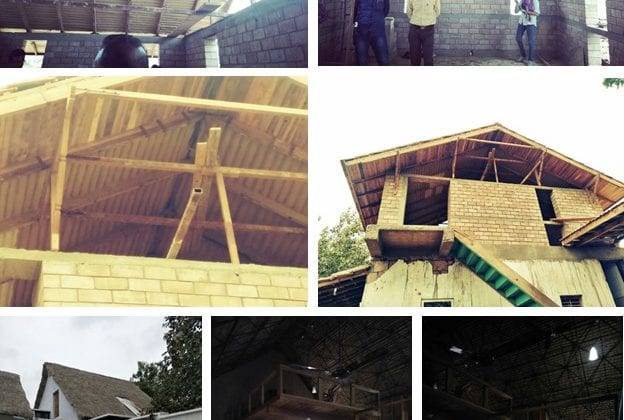

On 10.07.2018, we started our journey early in the morning from Karigarsala, where we spent our last night. We went on a site visit along with Hunnarshala to a village called Sanosara, which is thirty kilometers from Bhuj. It was an architectural project, a farmhouse using sustainable construction methods, for a young couple residing in that village. The clients, Ekta Ben, a native of Kutch and her French husband, have been practicing organic farming on 11 acres of land in the vicinity since 2013. The husband learned permaculture from France and is applying his learnings in the area. They export most of their produce to Mumbai and sell what is left to the locals at considerably cheaper prices. They seemed sensitive towards the concept of sustainability and have enthusiastically adopted earth construction even in their adjoining 3BHK bungalow designed by Kiran Wagela. This house is built in adobe and the scheme plays with levels in the section, including mezzanines and split-levels. Since the couple wants to start an eco-village in this location, they are planning to convert their old bungalow into a research center and the upcoming farmhouse to their main residence.

The farmhouse already has a ground floor built out of contemporary methods. Hunnarshala has taken up the construction of the first floor, which is essentially a room built out of materials and methods which us fellows have been acquainted with (however briefly) over the three-day workshop. The wall at the entrance is built in wattle and daub like the gable. The rest is compressed stabilized earth blocks (CSEB). The roof is made out of mud rolls, like at Kaarigarshala, which are supported by a wooden skeleton and covered on the outside with thatch, using the similar weaving and assembly technique as observed at Kaarigarshala again. On that particular site visit, the team was discussing the flooring of the structure and doing basic site supervision. They came to an interesting conclusion of stripping the tiles off of the wooden slab which acted as the roof of the ground floor and using the thus bare slab as a wooden floor.
Besides the above learnings of how site work happened when using earth construction, we also learned much about the organization, Hunnarshala, itself from the interns who are currently working there. Much of this we were not made aware of during the workshop. Hunnarshala has two departments – AU, which is the artisan empowerment unit, and CU, which is the community empowerment unit. The earth construction that we witnessed is pursued by the AU, and these materials and methods do not usually translate into CU’s work, which revolves around slum rehabilitation and community participation in that process. This disjunction is due to the politics involved in government projects, insufficient funding, invasiveness of concrete and more importantly lack of people’s faith in these sustainable materials. So earth construction, although not that expensive, seems to be restricted to a niche market. These AU projects, like The Villa Township we visited the previous day, thus cater mainly to the development of artisans, which is also extremely important to help them sustain themselves. Hunnarshala is currently working on the above discussed Ekta Ben house (handled by AU), Ahmednagar slum rehabilitation in Maharashtra (handled by CU), and also documentation at Spiti.